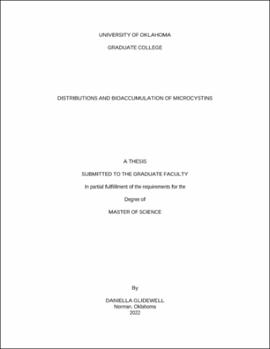| dc.description.abstract | Microcystins are hepatotoxins and tumor promotors, with various deleterious effects on plants as well. There are 270+ known congeners of the toxin microcystin, structural variants of the molecule. These hepatotoxins are produced by cyanobacteria, and are some of the most common toxins produced by cyanobacterial harmful algal blooms, or cyanoHABs.
Cyanobacterial harmful algal blooms are increasing in frequency and intensity worldwide. They are already a global threat to human health and ecosystems, occurring on every continent, and occurring from Antarctica to the arctic circle. They occur in freshwater, brackish water, and marine waters, and their toxins have been carried to terrestrial ecosystems as well. However, due to the number of congeners and the difficulties of monitoring their presence, more research is needed on their effects on ecosystems, their global distribution, and whether they can bioaccumulate or biomagnify in food webs.
In Chapter 1, I review the literature on microcystins in food webs. I compare the presence of microcystins in different trophic levels, habitat types, and taxonomic groups. I conclude that microcystin intoxication is widespread. I also conclude that more research is needed on microcystins outside of freshwater ecosystems and on how microcystins spread through food webs. In Chapter 2, I review the literature on the geographic distribution of microcystin reports. I conclude geographic disparities exist in the sampling and reporting of microcystins, and that these disparities have implications for global public health. In Chapter 3, I report a laboratory experiment which I ran to determine if microcystins can bioaccumulate or biomagnify in invertebrates. I fed microcystin-producing cyanobacteria to phytoplanktivorous zooplankton, and then fed those zooplankton to zooplanktivorous predators. I conclude that microcystins can be transferred between invertebrates, and that while microcystins likely do bioaccumulate they likely do not biomagnify. | en_US |
